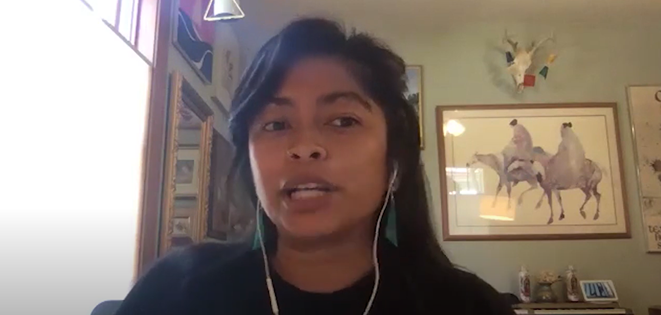
Consuelo Poland Lockhart, founder and executive director of the Latinas Welding Guild, said women working in manufacturing often feel alone. Organizations like hers provide a place to network and grow their skills. Screengrab via YouTube
It’s not a big secret that women are underrepresented in manufacturing. In 2019, women accounted for 29.4% of all workers in the sector, according to the Bureau of Labor Statistics.
So how can manufacturers bring more women onto the factory floor?
Indiana University’s Paul H. O’Neill School of Public and Environmental Affairs recently held a digital forum to examine ways to increase opportunities for women in manufacturing, outlining career paths and potential pitfalls for women in the field. In an hour-long discussion, the industry leaders emphasized the long-term goal of increasing employment for women in an industry long dominated by men.
“Manufacturing is a great career for women,” said Sue G. Smith, vice president for the school of Advanced Manufacturing, Engineering, and Applied Science at Ivy Tech Community College. “I’ve enjoyed it, and working with manufacturing companies [about] how to work with their employees. Manufacturing companies, I think, understand that they need to change their culture to attract and retain women.”
The idea of manufacturing in the popular conscience has led Smith and others to pursue other means of recruiting, and developing new, flexible approaches to appeal to a broad swath of workers.
“If we have 2 million jobs or 4 million opening in the next 10 years, the number is daunting… we need a national campaign to recruit diverse populations, including women, into these great manufacturing jobs,” she said. “We’re seeing the wages trend up, but we’re not seeing enrollment rise. We are poised to develop the manufacturing workforce.”
Consuelo Poland Lockhart, a founder and executive director of the Latinas Welding Guild, said she never saw herself pursuing a career in manufacturing. An artist by passion, Lockhart applied her skills to the welding trade – a position she found great satisfaction in, but one that scarcely had a history of female leadership, let alone employment opportunities.
“Other women,” she explained, “if you’re in this role, how do you advocate for yourself? The easy way is to just quit and not deal with it…[but] I said, ‘Well, if I really want to make this a career for myself, I gotta say something.”
Lockhart found her voice, and has dedicated her career to helping other women speak up, too. Lockhart’s organization assists women in navigating some of the inherent barriers to entry in the welding trade. From education to female mentorship, the Welding Guild empowers workers to pursue a future in manufacturing – and in the years since its founding, Lockhart has noticed a difference.
“When I first started off, I didn’t know any women in the industry… We saw and heard similar anecdotes about people feeling alone,” she said.
“Our community is meant to be a safe space,” she added. “We’ve been working and I do think things have improved. As we work with companies, we see more and more companies are committed to diversity, equity, and inclusion.”
Allison Grealis, a founder and president of Women in Manufacturing, illuminated the dynamic response her organization and others have implemented, including in response to the ongoing coronavirus pandemic. Employment options that provide additional education and give added support for childcare also help.
“Some companies have gotten creative,” Grealis said. “That provides them an ability to drop off and pick up kids from school… They’re looking at shared positions — so that multiple people can have opportunities to support their families. Returnship programs have been huge, where they’re helping highly skilled people back into the workforce.”
Smith echoed what Grealis has been seeing at a macro level, adding that it’s also vital for companies to help women gain job skills.
“I think it’s not only paying for the class, but those priorities and those resources to help learn a new skill,” she said. “One good thing that came from COVID, we were able to do a lot more… learn any time, learn anywhere, and that’s an opportunity as well. Another thing is time. In an apprenticeship, part of their job is to learn, so they have to learn on company time.”
When asked, “What are one or two things employers can do now?” to recruit women for these roles, Smith had this advice:
“The first step is looking at who are those partners locally. Having a built-in relationship with them is really important. Also, Manufacturing Day is huge… the day to showcase what modern manufacturing looks like. It has been hugely influential, so many women have stated that they never thought they’d be in a manufacturing career and it was by chance, and not design. A growing number have found out through a plant tour.”
Summarizing her view, Smith said employers need to “meet people where they’re at.”
You can watch the full program below.
